Table of Contents
Are you a fan of Korean cuisine? Or are you looking for a new way to spice up your meals? Look no further than homemade kimchi! This traditional Korean side dish is delicious and offers numerous health benefits.
From aiding digestion to boosting your immune system, eating kimchi is a flavorful way to promote your overall well-being. Plus, making your own kimchi allows you to customize the flavor. It ensures that you’re using fresh, high-quality ingredients.
The steps involved in making your kimchi at home will be outlined in this article, from preparing the vegetables to fermenting the final product. Prepare to delight your taste buds and make an impression on your companions with this effortless and savory kimchi recipe!
What is Kimchi / Kimchee?
Kimchi, also known as kimchee, is a spicy and tangy Korean side dish that is typically made with cabbage, radishes, green onions, and other vegetables that are seasoned with garlic, ginger, chili flakes, peppers, and other spices. The mixture is then fermented, which gives it a slightly sour flavor and a crisp texture.
In Korea, kimchi is more than just a side dish. It’s an integral part of the country’s culture and identity, with many families having their own unique kimchi recipe that has been passed down through generations. It’s also widely enjoyed throughout the world, with its popularity spreading across Asia, the United States, and beyond.
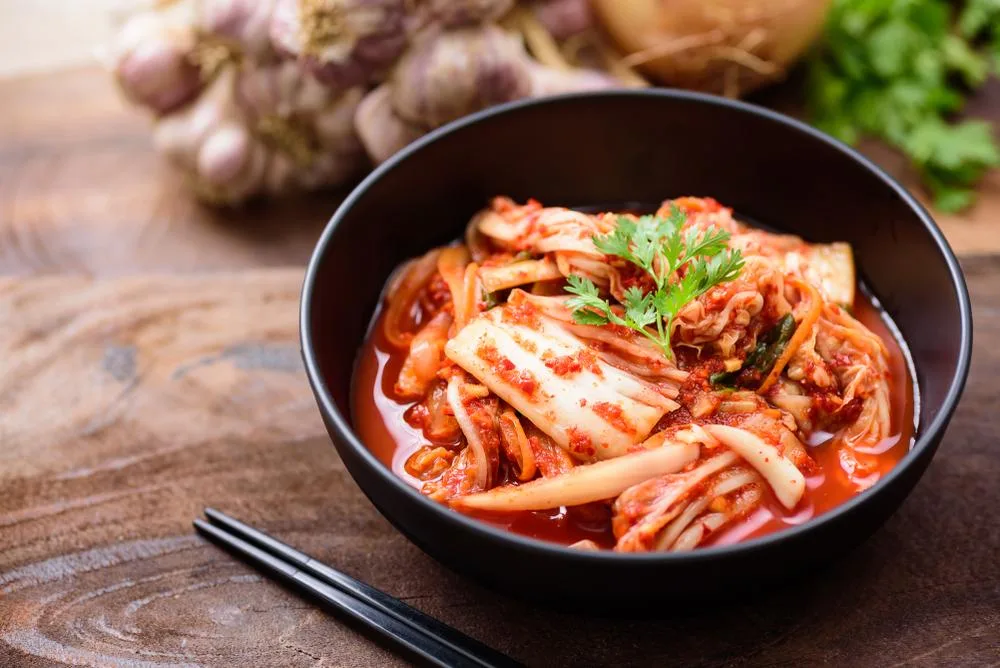
Benefits of Kimchi
Kimchi is more than just a tasty condiment. It’s also packed with health benefits. First and foremost, kimchi is an excellent source of probiotics, good bacteria that help support gut health. Probiotics have been linked to improved digestion, a stronger immune system, and even better mental health. Additionally, kimchi is low in calories but high in fiber, making you feel fuller for longer and aiding in weight loss.
Kimchi also contains a number of vitamins and minerals, including vitamin C, vitamin K, and potassium. These nutrients are vital for maintaining healthy bones, skin, and overall body function. Plus, kimchi is naturally low in fat and sugar, making it a healthy addition to any meal.
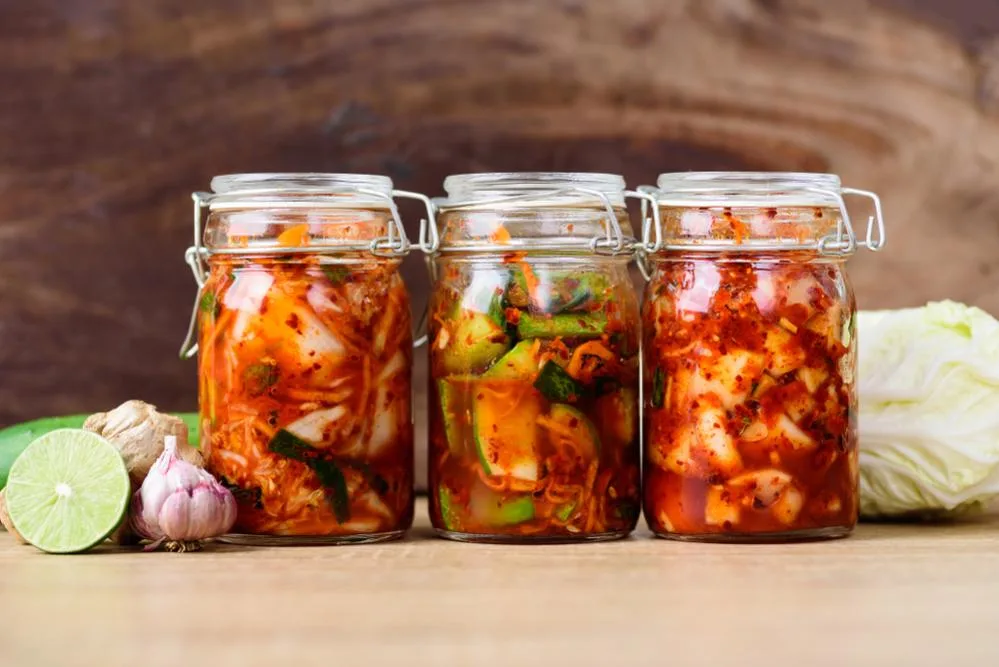
Why will you fall in love with homemade kimchi?
There are many reasons to really love kimchi. For one, making kimchi on your own allows you to customize the flavor to your liking. You can make it spicier, less sour, or even add different vegetables to create your own unique recipe. Plus, kimchi made at home is often fresher and more flavorful than store-bought versions.
Making your own kimchi can also be a fun and rewarding experience. It’s a chance to connect with Korean culture and learn about the fermentation process. Plus, once you’ve made a batch, you can use it in different dishes to add a spicy and tangy kick.
Kimchi-making tips
Making kimchi is relatively simple, but let’s have a look at some tips to keep in mind to ensure success. First, ensure you have all your ingredients prepped and ready to go before you start. This includes washing and chopping your vegetables, measuring out your spices, and mixing your brine.
Next, be sure to use high-quality ingredients. The flavor of your kimchi will depend on the quality of your vegetables, spices, and salt. Look for fresh, organic produce and high-quality Korean red pepper flakes and chili flakes.
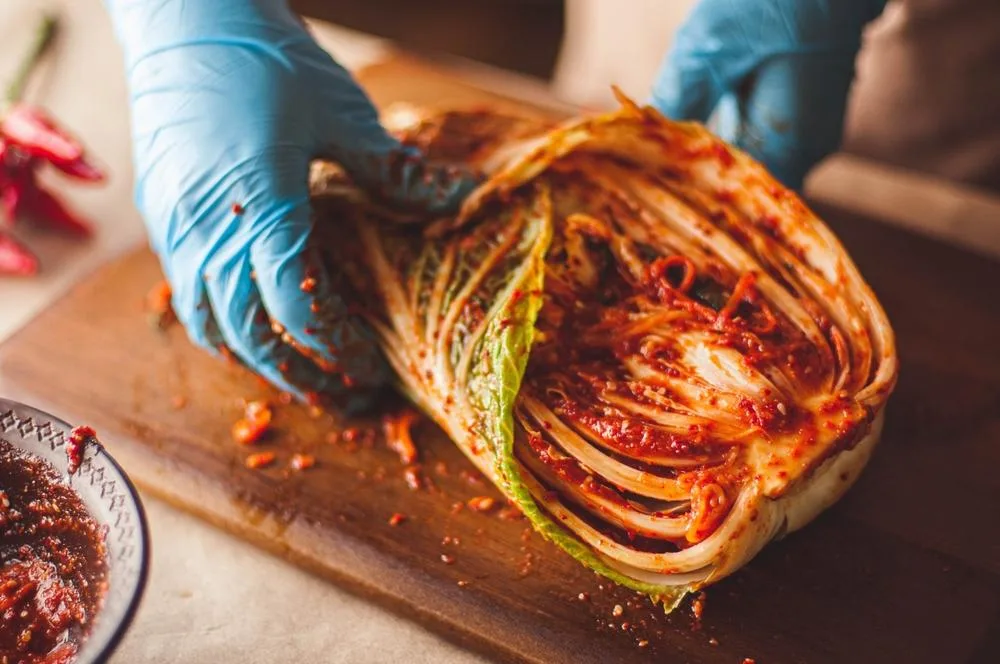
To protect your hands from spicy peppers, use gloves when mixing your brine. You might use a food processor to finely grind the spices and garlic, which will help distribute the flavor evenly throughout the kimchi.
Finally, be patient during the fermentation process. Kimchi typically takes 3-5 days to ferment at room temperature. Still, the exact time will depend on the temperature and humidity of your environment. Be sure to taste your kimchi daily to ensure it’s fermenting properly and adjust the flavor as needed.
Can I use different vegetables in my kimchi?
Yes! While traditional kimchi is made with Napa cabbage, you can also use other vegetables like Korean radish, cucumber, or even carrots.
How long will homemade kimchi last?
Properly fermented kimchi can last for months in the refrigerator.
Can I adjust the spice level of my kimchi?
Yes! Use more or less Korean red pepper flakes to amend the spice level to your liking.
I can’t find saeujeot (salted fermented small shrimps). What can I use instead?
Saeujeit can be obtained in Korean grocery stores in the refrigerator or freezer section. Asian grocery stores may stop carrying this product when the market is low. If you don’t find saeujeot, you could use Korean fish sauce.
Can I make vegan kimchi?
Yes! Simply omit the fish sauce or substitute it with a vegan-friendly alternative. Some popular substitutions to make kimchi include soy sauce, miso paste, or seaweed. You can also experiment with adding other ingredients, such as mushrooms or tofu, to create a unique and flavorful vegan kimchi.
Is it worth making your own kimchi?
Yes, making your own kimchi can be worth it, as it allows you to customize the flavor and ingredients to your liking. Additionally, homemade kimchi can be more cost-effective than store-bought options.
How long does kimchi take to ferment?
The time it takes for kimchi to ferment can vary depending on factors such as the temperature, amount of salt used, and desired level of fermentation. Typically, kimchi takes 1-5 days to ferment at room temperature but can take longer if refrigerated.
Is it better to ferment kimchi in the fridge?
Fermenting kimchi in the fridge will slow down the fermentation process and can result in a milder flavor. However, some people prefer the taste of kimchi that has been fermented at room temperature.
What are the mistakes with making kimchi?
Common mistakes when making kimchi include using too much or too little salt, not properly sterilizing equipment, using the wrong type of cabbage, and not properly packing the kimchi.
How safe is homemade kimchi?
It can be safe if proper hygiene and fermentation techniques are used. Using clean equipment and following a trusted recipe is important to prevent contamination with harmful bacteria. Additionally, consuming your kimchi within a few weeks is recommended to prevent spoilage.
Do you need a special jar to make kimchi?
While a special jar designed for fermenting kimchi can be helpful, it is not necessary. Kimchi can be fermented in an airtight container, such as a glass jar or plastic container with a tight-fitting lid.
How to store homemade kimchi
Once your kimchi has finished fermenting, storing it the right way is essential to keep it fresh and full of flavor. The best way to store kimchi at home is in an airtight container in the refrigerator. This will slow down the fermentation process and help preserve the flavor.
It’s important to note that kimchi will continue to ferment in the refrigerator, albeit slower. As a result, the flavor may continue to develop and become sourer over time. If you prefer a milder flavor, consuming your kimchi within a few weeks of making it is best.
What to do With kimchi
Homemade kimchi is a versatile ingredient that can be used in a variety of dishes. Here are just a few ideas for how to use your kimchi:
- Serve it with rice, grilled meats, or stir-fried dishes as a side dish.
- Add it to soups, stews, or noodle dishes for a spicy and flavorful kick.
- Use it as a topping for burgers, tacos, or sandwiches.
- Mix it into fried rice or scrambled eggs for a Korean-inspired breakfast.
- Use it as a condiment for dipping sauces, marinades, or dressings.
Kimchi ingredients
- Napa cabbage: is a low-calorie and nutrient-dense vegetable rich in vitamins C, K, and B6. It’s also a perfect source of dietary fiber, which helps support healthy digestion and keeps you feeling full for longer periods. The Napa cabbage leaves are usually used as a base for kimchi and provide a satisfying crunch that perfectly contrasts with the other ingredients’ tangy and spicy flavors.
- Daikon radish: is a type of radish commonly used in Asian cuisine, also known as white radish or Japanese radish. This root vegetable has a low amount of calories and contains a high dose of vitamin C, fiber, and potassium. It has a mild, slightly sweet flavor that complements the spiciness of the chili peppers and the pungency of the garlic and ginger. The daikon radish is usually grated and added to the kimchi paste, giving it a refreshing crunch and a touch of sweetness. You can also use Korean radish instead.
- Scallions: a type of onion with long green stalks and a mild flavor, commonly used in Korean cuisine as a flavoring and garnish. They have low calories and are high in vitamin K, which is vital for bone health, as well as vitamin C, which supports the immune system.
- Salted fermented shrimp: a type of salted shrimp that has undergone fermentation, which adds a pungent, salty, and slightly sweet paste that adds depth and complexity to the kimchi.
- Korean chili powder: a type of chili powder made from ground Korean chili peppers, which gives the kimchi its characteristic spicy flavor and vibrant red color. It is low in calories and high in vitamins A and C, essential for healthy skin, vision, and immune function. It also contains capsaicin, a compound that gives chili peppers their heat. It has various health benefits, such as reducing inflammation, improving metabolism, and aiding in weight loss.
Fish sauce: a condiment made from fermented fish, commonly used in Korean cuisine as a flavoring and seasoning for various dishes, including kimchi. It has a strong, salty flavor that enhances the other ingredients’ flavors. It adds a savory umami note to the kimchi.
How to Make Homemade Kimchi
Here is the easy way to make a perfect Kimchi at home:
Prep Time: 2 hr
Cooking Time: 0
Total Time: 2 hr
Makes 4 servings
Ingredients
2 large Napa Cabbage
1 cup Kosher Salt (Divided)
6½ cups Warm Water
Half-small Daikon Radish
1½ medium Red Apple (Divide)
1½ medium Korean Pear (Divide)
3 stalks Scallions
3 tbsp Salted Fermented Shrimp
1½ cups Water
4 tbsp Flour
1 cup Korean Chili Powder
2 tbsp Fish Sauce
9 small Garlic Cloves
2½ tbsp Fresh Ginger
Directions
- Clean the Napa cabbage. Cut the thick white part of the cabbage in half lengthwise.
- Then, slowly pull it apart by hand to separate it into two pieces. Use the knife to give one more cut on each half of the thick part of the cabbage.
- Dissolve 1/2 cup of salt in 6¼ cups water in a large bowl. Thoroughly bathe each cabbage in the saltwater one at a time, shake extra water back into the bowl, and then move it to another bowl.
- Using another 1/2 cup of salt, start from the outermost leaf, and spread a lot of salt on the thick white part of each leaf.
- Cover the dish with plastic wrap, and set aside for about 2 to 3 hours, rotating the bottom leaves to the top every 30 minutes. When the white parts of the leaves are easy to bend, the cabbage is ready to be washed. Rinse well, especially between the white parts. Drain well, add to a bowl, and set aside.
- Cut the radish, red apple, and Korean pear into matchsticks (use a Mandoline cutter, if desired), cut the scallions in about 4 sections, and mince the fermented salted shrimp.
- Add 1 cup of Korean chili powder, 2 tablespoons of fish sauce, 3 tablespoons of fermented shrimp in a bowl with the paste. Add the apple, radish, pear slices, and scallions. Mix well by hand. Taste a little bit. It should be too salty to eat as is. If needed, you can add salt, more salted shrimp, or fish sauce. Leave it to sit to allow the flavors to meld nicely.
- To make flour paste: Heat a small saucepan, add 1/2 cup of water and 4 tablespoons of flour, and bring to a simmer. Stir with a whisk while cooking to make the flour paste. When it’s done, transfer it to a large bowl.
- Core whole apple and pear, remove seeds, slice in half, and then again in half. Remove skin and cut. Place these ingredients and the garlic in a food processor or blender, and blend. Then add the mixture to the radish mixture, and mix well with your hands. With this step, the kimchi paste is done.
- Add one cabbage quarter to the bowl with the kimchi paste. Spread the mixture over each leaf, 1 to 2 tablespoons for large leaves. (Eyeball the mixture into 4 parts, and use one part for each cabbage quarter.)
- Fold the cabbage leaves over toward the stem and wrap them up nicely with the outermost leaf. Place it in a jar or airtight container. Once all the cabbages have been placed in the jar or airtight container, push down firmly to remove any air pockets. Store it in the fridge for a full day, depending on how fast you want your Kimchi to ripen.
Kimchi recipe variations
While traditional kimchi recipes call for the same core ingredients, there are countless variations and regional adaptations that can give this Korean classic a unique twist. Find below just a few of the many ways to make home-prepared kimchi your own:
Vegan or Vegetarian Kimchi: For those who don’t eat seafood or who prefer a plant-based diet, it’s possible to make kimchi without the fermented salted shrimp or fish sauce. Instead, you can add soy sauce or miso for a similar umami flavor.
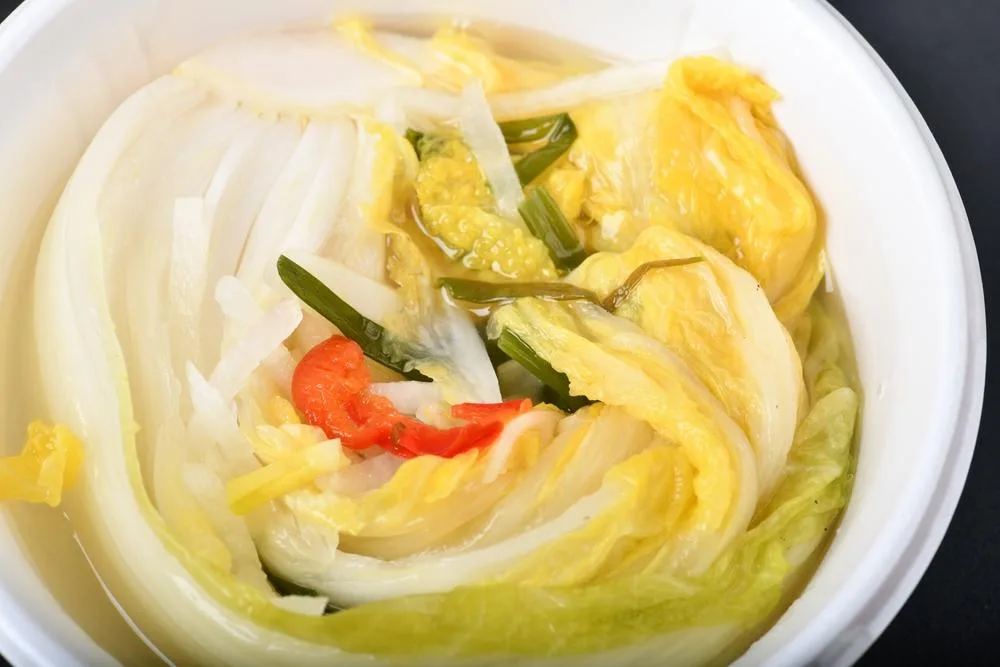
White Kimchi: While most kimchi is made with Napa cabbage and has a distinctive red hue, white kimchi is made with the same ingredients but without Korean chili powder. This results in a milder, slightly sweeter flavor that is still packed with probiotics and other health benefits.
Radish Kimchi: Daikon radish is a common ingredient in kimchi, but it can also be the star of its own version. Radish kimchi is typically made with sliced daikon radish and a simple garlic, ginger, salt, and sugar seasoning.
Baechu Kimchi: This is the most common type of kimchi, made with fermented Napa cabbage, Korean chili powder, garlic, ginger, fish sauce, or fermented salted shrimp. Fermentation gives the fermented cabbage a tangy, slightly sour flavor that complements the spice.
Reverse Kimchi: This variation on traditional kimchi involves fermenting the cabbage first, and then adding the other ingredients later. This can result in a milder flavor and a softer texture.
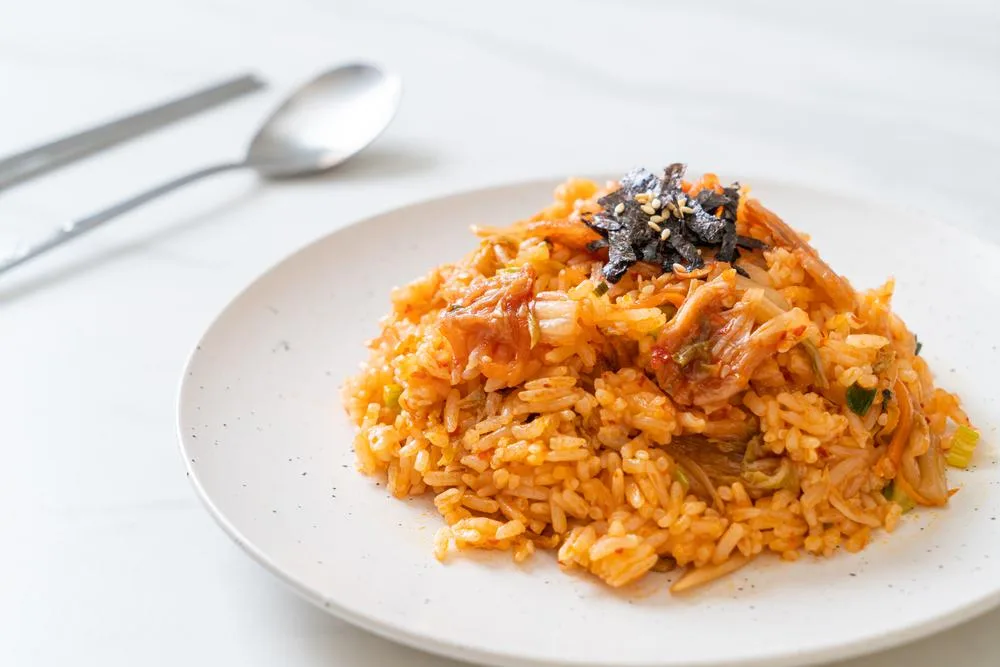
Kimchi Fried Rice: Leftover kimchi can be transformed into a delicious fried rice dish by sautéing it with cooked rice, vegetables, and protein of your choice. The spicy, tangy flavors of the kimchi add depth and complexity to this simple but satisfying meal.
Summary
In conclusion, making your own kimchi is a fun and rewarding experience that can bring a burst of flavor to your meals. This recipe provides numerous health benefits, such as boosting your gut health and immune system. The kimchi taste is a unique combination of spicy and sour flavors, and its versatility makes it an exciting addition to any kitchen.
Feel free to experiment with different ingredients or variations to make the recipe your own. In my personal experience, I’ve received nothing but positive feedback from friends and family who have tried this recipe. I encourage you to share your experiences and thoughts in the comments or on social media, as it fosters community and learning.
Check out our related articles and recipes on our website to learn more about Korean cuisine. Finally, thank you for your time and attention, and I hope this recipe inspires you to create delicious, healthy meals in your own kitchen. Try it and enjoy the delicious taste of kimchi! Tell your friends and family about this recipe, or subscribe to our newsletter for more exciting content. Happy cooking!
















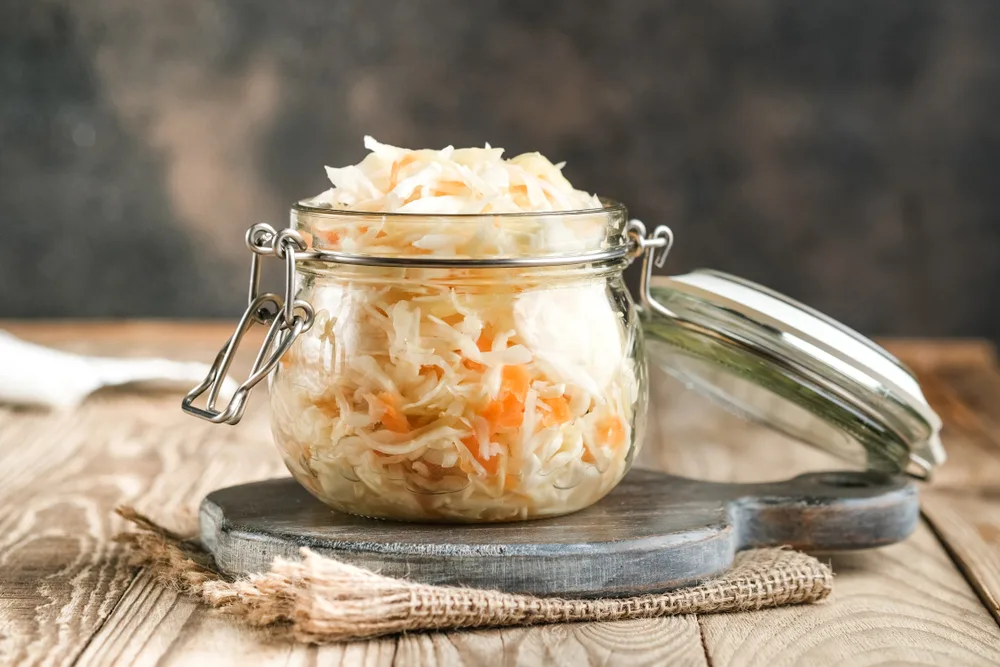
Comments
0